Search magnets for gold
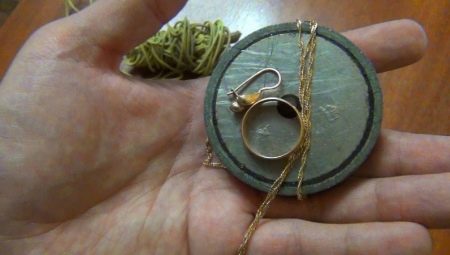
Under search magnet it should be understood as a kind of device with which you can find the places of magnetic radiation that emanate from objects made of various metal alloys. A magnetic field is generated by electrons that emit mobile electrical charges. Strong magnets are used to find precious metals, including gold or silver... But since precious metals do not react to magnetic fields, then special devices are used to detect them, which include the chemical element neodymium... These search magnets are called neodymium magnets.
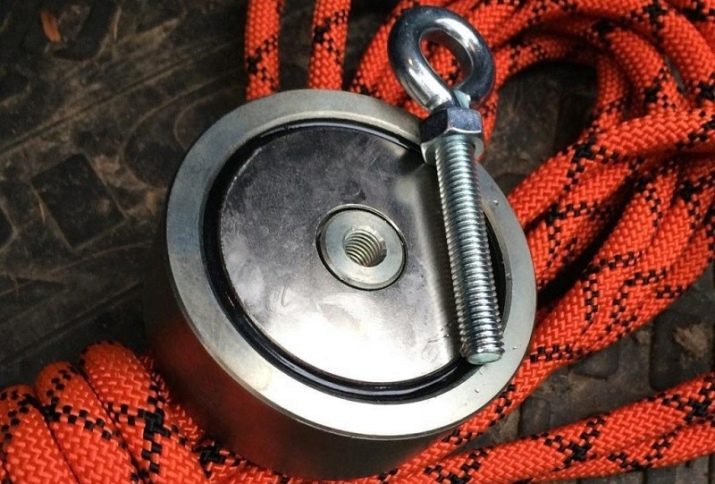
What it is?
Neodymium magnet Is a device that attracts various metal objects. It is capable of grabbing and pulling objects, the weight of which can exceed its own mass by tens of times. This is a rather powerful search device, which contains neodymium, iron, boron. The components of the magnet are housed in a steel case, which is usually flat and round.
To extract the found items conveniently, the design of the search engine is equipped with repair bolt, which is screwed into the body using a threaded connection. Tied to this fastener strong rope or cable - with their help, you can lift a magnetised object even from the depths of the water basin.
Any precious metals (including gold) have in their composition a certain composition of the ligature, which makes the material hard and ductile. Alloys contain ferromagnetic components that are attracted to the neodymium device.... This is how the jewelry is discovered and brought to the surface.
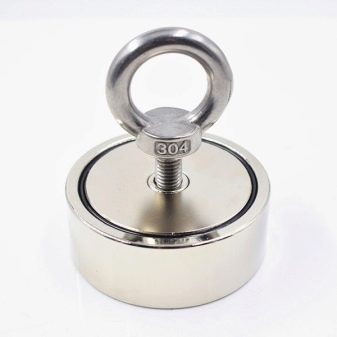
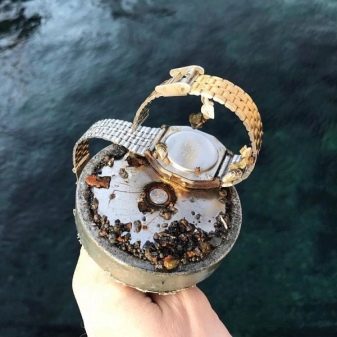
Design and types
The neodymium search engine is available in several varieties. Such devices can be used in everyday life, when solving search problems in private, research or industrial purposes... Options for neodymium fixtures can vary from each other in power and size.
Depending on what neodymium magnets are intended for, they are divided into 4 types.
- Bar magnets. They feature a narrow design designed to work in hard-to-reach places or narrow crevices.
- Search trawls. Magnets used to survey the bottom of rivers, lakes or other bodies of water.
- Single sided magnets... They have only one working surface, with the help of which metal objects are detected and lifted.
- Double-sided magnets... They have two working surfaces, which is why such a device is considered universal.
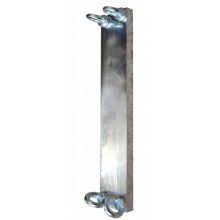

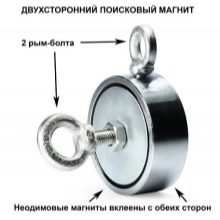
Fixtures with one work surface are used for prospecting works on the surface of the soil. In the case when it is required to search for metal objects at the bottom of the reservoir, it is more expedient to use a structure that has two work surfaces. If long and large-scale work is coming up on a large surface area hidden under the water column, it is used magnet trawl. With the help of such a device, objects can be attracted from a great distance and considerable mass.
Any neodymium search engine containing iron in its composition is exposed over time corrosive processes, due to which the strength of its magnetic field gradually decreases.
To extend the durability of the search device, manufacturers began to cover their products with a protective layer against corrosion - a layer of aluminum, zinc or polymer compounds.

Neodymium magnets are considered to be the strongest when they are compare with other analogs. When several magnets are connected to each other, the strength of their magnetic field increases, but by only 30%, while each pole of the magnet has an equivalent force of attraction. The gravity of a neodymium device is influenced by the ambient temperature.
It is noticed that at temperatures exceeding + 80 ° C, such a magnet loses its attractive ability and strength.
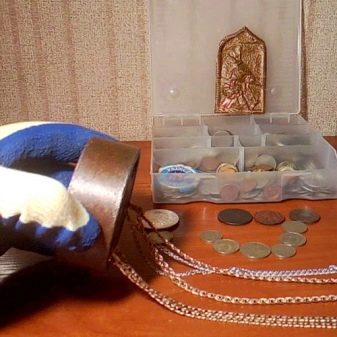

Will pure gold be able to magnetize?
Neodymium gold prospecting magnet is a rather sensitive and strong device, which is capable of detecting even small amounts of impurities contained in the gold alloy. He does not only magnetise on precious metals, but also takes any others that are in his field of action.
Neodymium devices began to be used to search for precious alloys due to the fact that The rare earth metal neodymium, which is part of this magnet, is known as a compound that has a magnetization function and is resistant to demagnetization. In addition, this element is used in the manufacture of especially powerful magnetic devices and devices that are capable of reacting to ferromagnetic components located at a great distance from the magnet.
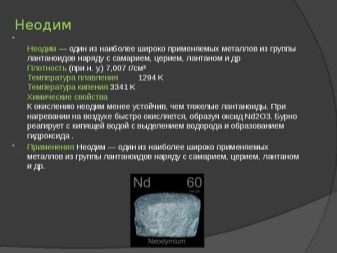
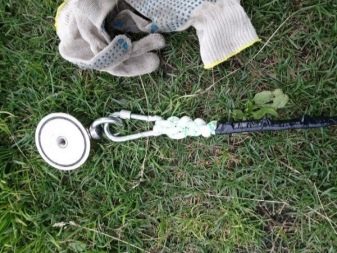
Objects made of gold or silver are captured by the neodymium search engine due to the impurities in them of other metals that make up the ligature. And although the amount of impurities in the composition of a gold product or alloy may be very small, sensitive neodymium will still detect the ferromagnetic components of the ligature in the alloy and magnet them along with all the rest of the contents.
Pure - without any impurities - gold has diamagnetism, that is, it is not attracted by the magnetic field of a magnet, but, on the contrary, is repelled, showing negative susceptibility. It turns out that even a neodymium magnet cannot detect an ingot of pure gold. Pure gold can only be found with the help of a metal detector, the principle of operation of which is not aimed at extracting metal objects, but at alerting them about their presence within a certain range of the device.
However, gold jewelry and ingots can also be attracted by a magnetic finder if the treasure is in a casket or casket, for example, made of aluminum, tin, lead, copper.

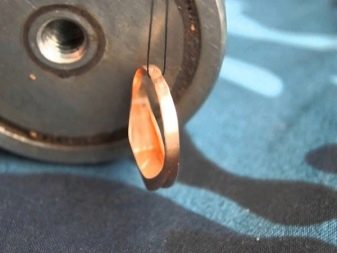
Popular models
Treasure hunting has always been a popular and interesting activity. Modern prospectors of precious metals use rather large and powerful double-sided neodymium magnets in their searches, since they are universal in work.
To find a search magnet, you need to determine in what conditions it is planned to be used. In addition to the magnet, you need to purchase cable or strong rope - it is best to choose them with a certain margin of safety, since no one for sure can know what will have to be raised to the surface. The strength of the cable, as a rule, is chosen 2 times greater than that required for the operating power of the magnet. This will save you from accidental breaks of fasteners and the irreversible loss of the search device.
This precaution is especially relevant when prospecting underwater.
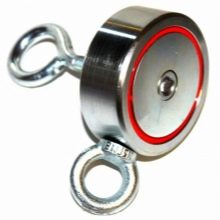

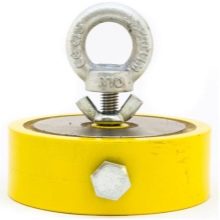
The most popular are the following manufacturers of neodymium magnets.
- Moscow research and production company "Supersystem". Single-sided magnet model F-600 with a diameter of 130 mm. The pull-off power is 660-690 kg, the cost is 4500 rubles.
- Kaluga Research and Production Association "REDMAG"... Produces a one-sided F300 magnet with a diameter of 94 mm. The pull-off power of this option is 600 kg, the cost is 3000 rubles.
- Magnets made in China... For example, the F400 with a diameter of 116 mm. The pull-off power is 400 kg, the cost is 3500 rubles.
When choosing a neodymium magnet for searching for gold and silver, it should be remembered that the power of a magnet directly depends on how much mass it can lift to the surface.
The averages have magnets with a lifting force of 400 kg.
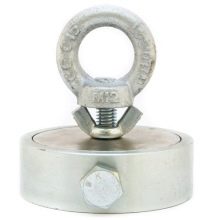
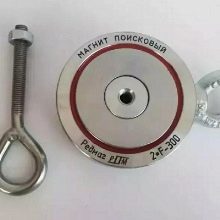
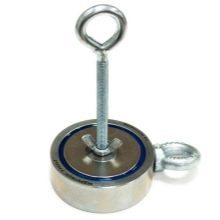
Selection Tips
Search neodymium devices have marking with the English letter F (Force - force) with a numerical designation that corresponds to the power of the device. If the search magnet is double-sided, then its designation will look, for example, like this: F400x2 (where the number 2 means that the model has two working surfaces). When choosing a device for finding gold, you should take into account that the power of a neodymium search engine will manifest itself in different ways in different conditions. Under ideal conditions, the new device can show power even higher than the declared one, but in practice, during operation, the force of attraction will be somewhat reduced. This is influenced not only by the corrosion of the magnetic material, but also by various contaminants that occur on the soil or at the bottom of the reservoir.
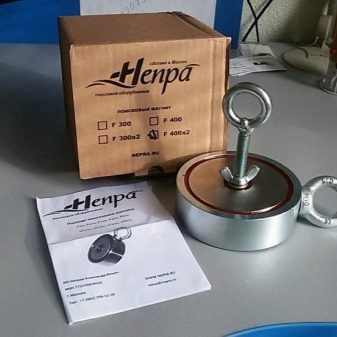

Besides, the contact area of a neodymium search engine and a metal object depends on how flat the surface of the found object is... Powerful devices for finding metal have a greater holding force than weaker models, so the number of so-called gatherings of objects found in small magnets will be much higher. Small neodymium attachments (type F150 and F200) are designed to search for small items - coins, rings, fishing lures. Medium models, the capacity of which is from 250 to 800 kg, will help you find objects that are large in weight and size, but it is difficult to work with them, since the mass of such neodymium devices is also large and throwing them, for example, into water is quite physically difficult.


The choice of a neodymium magnet for precious metals tracing depends on whether what objects by mass and size you want to find. In addition, you need to focus on your own physical capabilities - will you be able to work with a magnet. And one more factor should be taken into account - the more powerful the magnet, the greater its weight and cost. Therefore, the choice of a model also depends on your financial capabilities.
According to the reviews of experienced search engines, the cost of a powerful magnet pays off much faster than the cost of low-power analogs. For this it is necessary to carry out no more than 5 search exits. The fact is that a powerful magnet can collect many more different metal objects in one go than can be done with a small neodymium device even in several exits.
When choosing a neodymium magnet for gold prospecting, you also need to determine how many working sides it should have... One-sided search devices are used to detect metal in a well, at the ground surface. And also it is convenient when casting from a bridge, pier or boat. If you want to throw a neodymium magnet from the shore, then the double-sided option is most effective. The same magnet can be used both from a boat and from a bridge - that is why it is considered universal among treasure hunters.
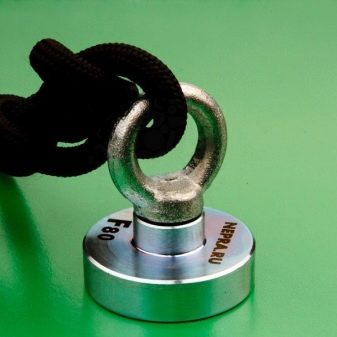
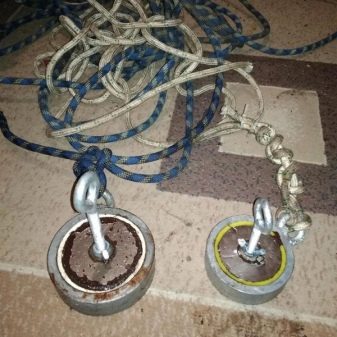
You can learn how to mine gold with a magnet in the next video.








